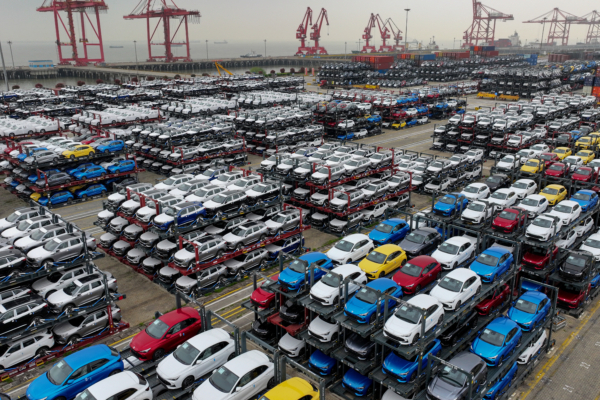The Chinese Communist Party’s focus on driving high-end manufacturing industries while neglecting domestic consumption policies implies that it will rely on other countries’ domestic demand to sustain economic growth, potentially becoming the root cause of trade conflicts.
The collapse of the Chinese real estate industry has led the CCP to bet on high-end manufacturing, positioning “modern industries” as the key to economic growth.
During the pandemic, Chinese banks have shifted the priority of credit to support manufacturing, with new loans to the real estate sector plummeting from over $1 trillion by the end of 2018 to nearly zero, while new loans to manufacturing have surged from around $60 billion to nearly $700 billion in the third quarter of 2023.
According to Trade-in-Value Added (TIVA) data, China’s share of global manufacturing capacity reached around 35% in 2020, with its manufacturing exports accounting for about 20% of global manufacturing exports that year.
Especially in industries like new energy, represented by the so-called “new three items” (electric vehicles, batteries, and solar panels), production capacity has rapidly increased. Due to weak domestic demand, this surplus production capacity is being redirected towards foreign markets.
The proliferation of cheap Chinese goods globally has sparked concerns of “China Impact 2.0” in various countries.
In 2022 and 2023, China saw record trade surpluses with countries worldwide and the total trade deficit against China reached $822 billion in 2023, doubling from $420 billion in 2017.
Sun Guoxiang, associate professor at the International Affairs and Business Department of Nanhua University in Taiwan, stated that the CCP has heavily subsidized key manufacturing sectors such as chips, electric vehicles, solar panels, artificial intelligence, 5G technology, and high-end machinery, focusing on research and development of critical technologies, industry clusters, and market promotion.
While these subsidies have boosted China’s industrial capabilities in the short term, they often lead to market distortions and excessive investments, resulting in overcapacity as many companies rely on government support rather than market demand, forcing them to seek markets through increased exports.
Sun emphasized that unless China significantly boosts domestic consumption and demand, overcapacity and the resulting international trade conflicts will be challenging to avoid.
Since the Central Economic Work Conference in 2004, the CCP has aimed to shift the economy’s focus from investment and exports to domestic consumption. However, two decades later, China’s economy still heavily relies on investments and exports, with household consumption accounting for only 39% of GDP, significantly lower than the OECD average of 54%.
As global concerns over China’s industrial policies grow, potential trade conflicts loom on the horizon unless China manages to substantially increase domestic consumption.
The use of tariffs against China by the US and other G20 countries has been increasing since 2018, with a new round of tariffs likely in 2025. Moreover, European and most G20 countries agree on the need to address China’s manufacturing overcapacity.
Governments around the world are becoming wary of the “China Impact 2.0.” In the past four years, policies targeting electric vehicles, batteries, and solar panels imported from China have escalated, with anti-dumping and anti-subsidy investigations initiated by several countries and regions.
Analysts believe that China’s economic decline is exacerbating this trend, with Beijing needing to continuously expand manufacturing and exports to maintain its 4% – 5% economic growth target. This could potentially lead to a scenario where China’s rapid growth comes at the expense of other major economies, necessitating a tolerance for declining global market shares in manufacturing.
As Western countries work to cultivate advantages in green technology and provide new jobs for workers displaced during the green transition, China’s flood of green technology exports is challenging the core interests of Western economies.
Sun Guoxiang pointed out that China’s reliance on manufacturing and export-driven external demand means its economic performance is closely tied to global market needs. As China continues to expand trade surpluses while domestic demand remains weak, the imbalance in the global economy will become more apparent, becoming a significant trigger for trade conflicts.
With increasing scrutiny on China’s trade practices globally, the CCP’s commitment to manufacturing prioritization over consumption-led growth is seen as a potential threat to fair market competition. From a Western perspective, these measures are aimed at maintaining market fairness rather than protecting domestic industries alone.

